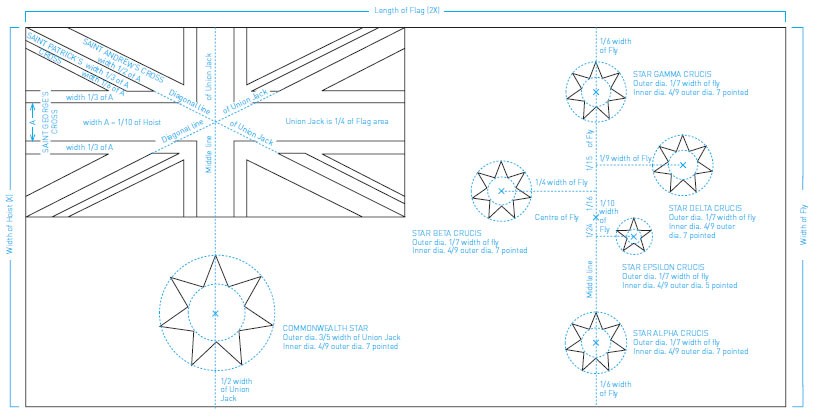The elements of the Australian National Flag

The Australian National Flag consists of three elements:
- the Union Jack
- the Commonwealth Star
- the Southern Cross.
Colour references for the Australian National Flag are:
Blue: PANTONE® 280
Red: PANTONE® 185.
The Union Jack
The Australian National Flag has the Union Jack in the upper left-hand quarter nearest the flagpole (the ‘canton’) to acknowledge the history of British settlement in Australia. The rest of the background (the ‘field’) is coloured dark blue. The Union Jack, the commonly used name for the Union Flag, is the flag of the United Kingdom of Great Britain and Northern Ireland and has its own history.
The first Union Flag, created in 1606, combined the red cross of St George (England) on a white background and the white diagonal cross of St Andrew (Scotland) on a dark blue background. When Ireland became part of the United Kingdom in 1801, the red diagonal cross of St Patrick was added to the Union Jack.

THE UNION JACK
The Commonwealth Star
The Commonwealth Star on the Australian National Flag created in 1901 had six points representing the states (formerly colonies). The seventh point was added in 1908 to represent Commonwealth territories. Another reason for this change was for the star to match the crest of the Commonwealth Coat of Arms, the first version of which was created in 1908. The Commonwealth Star is sometimes referred to as the Federation Star.

THE COMMONWEALTH STAR
The Southern Cross
Four seven-pointed stars arranged in a cross, together with a smaller five-pointed star appear on the right-hand side (the ‘fly’) of the flag to represent the Southern Cross. The Southern Cross is a constellation that can be easily seen in the night skies of the Southern Hemisphere. It was a common feature of many of the early unofficial Australian flags. The formal name of the Southern Cross is Crux Australis and the individual stars are known by the first five letters of the Greek alphabet in order of brightness: (clockwise from the bottom star) Alpha, Beta, Gamma, Delta and Epsilon.
The original competition-winning design had each star with a different number of points, ranging from nine to five, to reflect their brightness. The number of points was simplified and the official drawing in the Commonwealth of Australia Gazette on 23 February 1903 showed the four larger stars of the same size with seven points each and one smaller star with five points.

THE SOUTHERN CROSS
Australian National Flag Day
Australian National Flag Day was proclaimed by the Governor-General on 28 August 1996 and has been observed since 3 September 1996.
Australian National Flag Day acknowledges the first time the flag was officially flown on 3 September 1901.
Australians can celebrate Australian National Flag Day by flying or displaying the Australian National Flag on 3 September each year.
